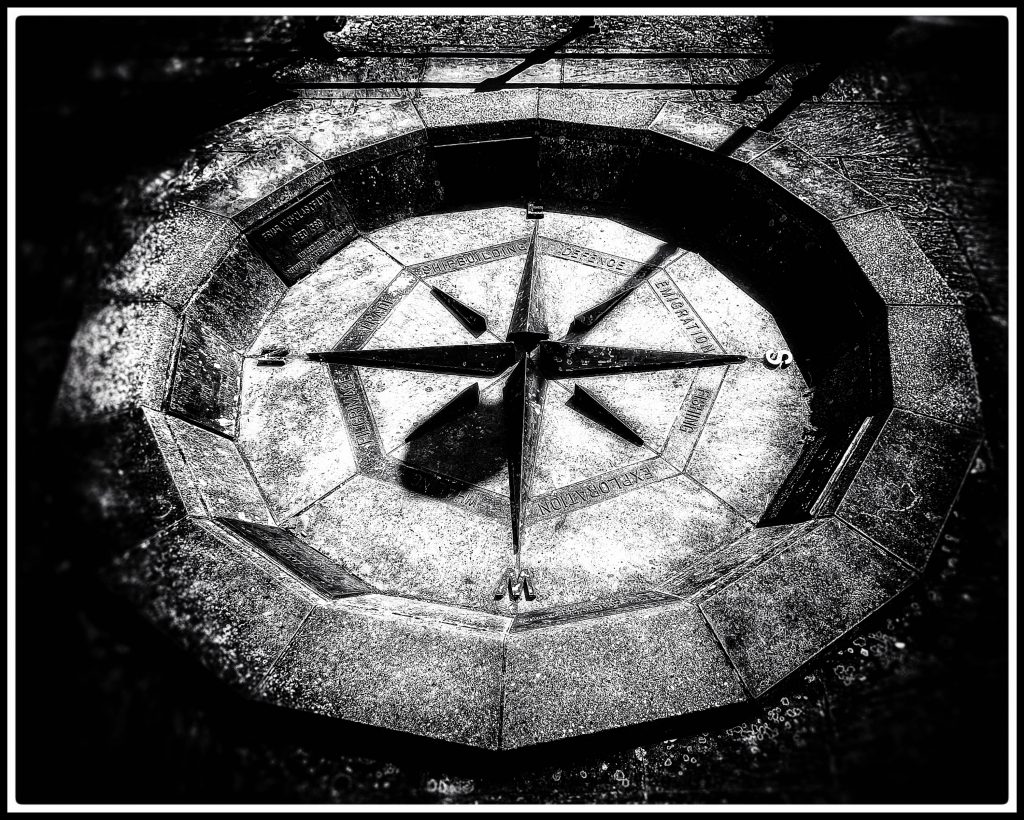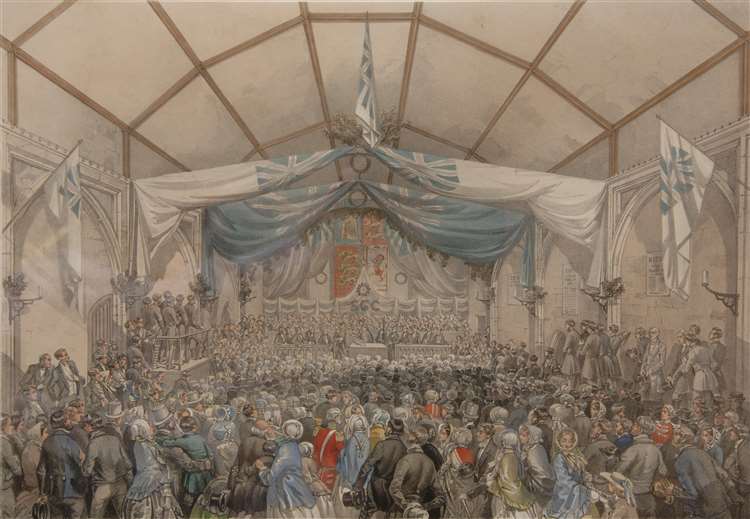The Compass Plaques on Purfleet Quay, King’s Lynn. Explorers and Adventurers.

Photo © James Rye 2022
On the Purfleet Quay there is a compass rose with plaques commemorating eight significant people with links to King’s Lynn. The eight people, reading clockwise from north, are explained below.
Friar Nicholas of Lynn
Friar Nicholas was born in Lynn and was a Carmelite Friar. He later moved to Oxford and developed a reputation for his scientific work. In 1386, at the request of John of Gaunt (one of Edward III’s sons) Nicholas published a Kalendarium of detailed astronomical tables covering the years 1387–1462. This was designed for use in the astrologically-based science of the time.
The tables were very sophisticated, even including rules for synchronising medical treatment with astronomical cycles, such as the right phases of the moon for blood-letting. His contemporary Geoffrey Chaucer wrote very approvingly of Nicholas’ work, and made much use of it.
Later in life he moved to Cambridge where he was promoted to subdeacon in 1410 and to deacon in 1411. The date of his death is unknown.
Earlier claims that Nicholas was the Franciscan who voyaged to Iceland and reputedly discovered the Americas and who died in 1369 are now seriously questioned.
Admiral Lord Nelson (1758-1805)
In 1798 Nelson was made a Freeman of King’s Lynn. Lathe Street was also renamed after him.
He is most famous because of his battles against the French, and notably his victories at the Battle of the Nile in 1798, the Battle of Copenhagen in 1801, and in the Battle of Trafalagar in 1805. In 1794 he lost his right eye in the Battle of Calvi and his right arm in the Battle of Tenerife. He died on 21 October 1805 at the Battle of Trafalagar during which his daring tactics secured a remarkable victory for the British. He is buried in St Paul’s Cathedral.
Nelson wasn’t born in Lynn but in Burnham Thorpe, Norfolk, where his father, Rev. Edmund Nelson, was Rector. Horatio was made a Freeman of King’s Lynn in 1798.
King Edward IV (1442-1483)
Edward IV deposed the weak and mentally-unstable Henry VI and was crowned king in London in 1461. Between 1455 – 1487 the supporters of Henry VI (known as Lancastrians) fought supporters of Edward IV (known as Yorkists) in the Wars of the Roses. King’s Lynn was known as a Yorkist supporting port. In 1470 Edward was facing a Lancastrian coup by the Earl of Warwick. Edward narrowly escaped capture by sailing to the continent from Lynn and took refuge in Bruges.
Edward returned to England in 1471 backed by Flemish merchants. The tangible impact that this return had on King’s Lynn can be seen in the building of the Hanseatic Warehouse (see HERE for more details).
Admiral James Burney (1750-1821)
James Burney was born in London but moved to King’s Lynn as a child and was part of the famous Burney family who lived in the town. His father, Dr Charles Burney was a composer, music scholar, and organist at St Margaret’s. His sister Fanny was the famous diarist and novelist.
Through his father’s influence he sailed from 1772 on Cook’s final two voyages to the South Seas and, like another famous King’s Lynn sailor, George Vancouver, witnessed Cook’s death in Hawaii in 1779. He was promoted to Captain in 1782 but retired through ill health in 1784.
He later wrote two books on naval voyages and a third on the game of whist.
After the personal intervention of the Duke of Clarence (later William IV) he was promoted to Rear Admiral in 1821 just before his death. He was buried in St Margaret’s in Westminster.
Captain George Vancouver (1757-1798)
George Vancouver was born in King’s Lynn and was the son of the Deputy Collector of Customs working at the famous Custom House. At the age of 14 he sailed with Cook to the South Pacific, the Antarctic, and the South Atlantic. He was with Cook when he was killed in the Sandwich Islands in 1779. Vancouver rose through the ranks and developed his skills as a surveyor.
In 1791 he was sent to survey South West Australia and the west coast of America north of San Francisco. It was hoped that he would discover the North-West Passage. The four and a half year voyage covered 75,000 miles.
Vancouver’s expedition was the first to produce detailed charts of the waters around the City of Vancouver and the city was named after him. He has several other places and mountains named after him, including Vancouver Island, as well as Vancouver, Washington in the United States.
Vancouver’s maps were used by all nineteenth-century mariners sailing from present-day Oregon to the Aleutians, and they were consulted during the Oregon Treaty negotiations in 1846. Despite the accuracy of his maps, Vancouver failed to discover the North West Passage and he said that it didn’t exist.
He retired in ill health and was stalked by a deranged member of the aristocracy (for more details see HERE). Vancouver died in 1798 and is buried in Petersham in Surrey.
Captain Samuel Gurney Cresswell (1827-1867)
Cresswell was born in Bank House in King’s Lynn. After joining the navy as a boy he ended up with Sir John McClure in 1849 on a trip to find both the North West Passage and Sir John Franklin’s ship that had not returned from its own search to find the elusive route through the northern ice. Cresswell was appointed as the second lieutenant and ship’s artist aboard HMS Investigator for the expedition.
The Investigator ended up being trapped in ice for two years, and eventually it was decided to abandon ship in 1853. Cresswell, along with 24 invalids, followed his commander, McClure, on a 170 mile trek to Kellett’s winter camp located off Melville Island. Because he was in good health, Cresswell volunteered to continue overland for about another 300 miles to Beechey Island in the hope of meeting a ship. In the process he discovered and crossed the route that had eluded the other sailors.
Luckily, he succeeded in making the epic sledging journey and also actually managed to find a ship home. Cresswell set sail for home in August 1853 with proof of the existence of the North West Passage and the acclaim of being one of the first naval officers to cross it.

On 26 October 1853, a public dinner was held in Cresswell’s honour at the King’s Lynn Assembly Rooms, organised by his native townsmen. Tickets were 1 guinea each. In gratitude for his safe delivery home he gave money for the creation of a new East Window in St Margaret’s Church.
Admiral Sir William Edward Parry (1790-1855)
William Edward Parry spent the latter part of his life living in Castle Rising married to his second wife, Catherine Hankinson, whose father had been a vicar of St Margaret’s.
Parry was born in Bath in 1790 and educated at Bath Grammar School. In 1803, a family friend, Admiral William Cornwallis, took Parry to sea and he quickly earned the respect of senior officers, marking the beginning of his naval career. From 1806 to 1817, Parry served on many ships along the French coast, in the Baltic and North seas and in North America before returning to England.
Parry was involved in four expeditions in search of the North West Passage: the first as lieutenant under Captain John Ross (1818), followed by three of his own ventures (1819-20, 1821-23, 1824-25). A fifth and final expedition attempted to locate the North Pole (1827). While each of Parry’s ventures were unsuccessful, he made significant contributions to European knowledge of the Arctic.
Captain John Smith (1580-1631)
John Smith was an English soldier, explorer, colonial governor, and author. He played an important role in the establishment of the first permanent English settlement in America in the early C17th.
Smith was born in Willoughby in Lincolnshire but in 1595 he was apprenticed to the wealthy merchant Thomas Sendall in King’s Lynn. This seems to have been an amicable arrangement, but after Smith’s father died in April 1596 and his mother remarried, Smith terminated his apprenticeship and left England.
He served as a soldier on the Continent, but by 1608 he had become a leader of the Virginia Colony, and was exploring along the rivers of Virginia and the Chesapeake. He became the first English explorer to map the Chesapeake Bay area. Later, he explored and mapped the coast of New England.
Jamestown was established in 1607. Smith trained the first settlers to work at farming and fishing, thus saving the colony from early devastation.
Smith’s books and maps were important in encouraging and supporting English colonization of the New World. Having named the region of New England, he stated: “Here every man may be master and owner of his owne labour and land. …If he have nothing but his hands, he may…by industries quickly grow rich.”
Smith was quite a “colourful” character and was not averse to exaggeration. He claims that his life was once saved by a young woman from the Powhatan tribe (the king’s daughter) known as Pocahontas. This account is doubted because it didn’t appear in the earlier accounts of Smith’s time in America but appears to have been inserted later.
John Rolfe (originally from Heacham) wanted to cement good relations between the first nation people and the colonists. He persuades Pocahontas to marry him. After she had been baptised, he brings her and her son back to the court of King James in 1616. Rolfe was by now the Colony’s secretary, and the visit served as excellent propaganda for the new settlement which still had a pressing need to attract more capital and manpower to prosper. The couple were received at the Royal Court, and Pocahontas became widely feted.
There is a local tradition that the couple made it to Heacham for a while before returning to the Colony, but the evidence for this is only traditional. Pocahontas only made it to Gravesend where she died before the return journey to America.
Book a Walk with a Trained and Qualified King’s Lynn Guide
© James Rye 2022
See also: King’s Lynn’s Third Most Famous Sailor?
Sources
https://en.wikipedia.org/wiki/Nicholas_of_Lynn
https://en.wikipedia.org/wiki/Horatio_Nelson,_1st_Viscount_Nelson
https://en.wikipedia.org/wiki/Edward_IV_of_England
https://en.wikipedia.org/wiki/James_Burney
https://en.wikipedia.org/wiki/George_Vancouver
https://en.wikipedia.org/wiki/Samuel_Gurney_Cresswell
https://www.gracesguide.co.uk/William_Edward_Parry

[…] See also King’s Lynn’s Compass. […]